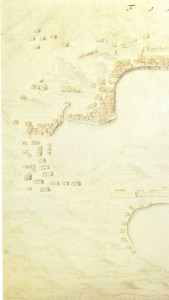
John Saris (1580-1643), the Master of the mission and Captain of The Clove wrote a ‘ship’s log’ which we are fortunate to be able to read, 400 years later..
This is the the entry on 11th June, as they first arrived in ‘Hirando’ or ‘Firando’ (modern day Hirado city in Nagasaki Prefecture, Kyushu 平戸市 Hirado-shi):
“About 3 in the afternoone wee came to an ancker half a league short of Firando, the tide soe spent, that wee could not gett further in. Soone after I was visited by the olde kinge Foyne Sama, and his nephew Tone-Sama, Governour then of the Island under the ould kinge. They were attended with 40 boates or gallies rowed some with 10, some with 15 oares on a side: When they drew neere to the ship, the kinge commaunded all but two wherein him self and his nephewe were to fall a sterne, and they onelie entred the ship, both of them in Silke gounes, guirt to them with a shirte, and a paire of breeches of Flaxen cloth next theire bodies; each of them had two Cattans or swords of that countrie by his side, the one of half a yarde longe, the other about ¼ . They weare no bandes. The fore parte of theire heads were shaven to the crowne, and the reste of theire heare, which was verie longe, was gathered together, and bounde upp on a knott behinde, wearinge neither hatt nor Turbant, but bareheaded. The kinge was aged about 72 yeares, his nephew or Graund child, that governed under him, was about 22 years old, and either of them had his governour with him, whoe had commaunde over their slaves, as they appointed him.
Theire manner and curtesie in salutinge was this, Vizt. First in presence of him whome they are to salute, they putt of their shooes (stockings they weare noone) and then clapping their right hand within theire left, they putt them downe towards theire knees, and soe wagginge or moving of theire hands a little to and fro, they stooping stepp with smale stepps sideling from the partie saluted, and cry Augh, Augh. I ledd them into my cabynn, where I had prepared a Banckett for them, and a good consorte of Musique which much delighted them. They badd me welcome, and promised me intertainement. I delivered our kinges letters to the king of Firando, which hee receaved with great ioye, saying hee would not open it, till Ange came, whoe could interprett the same unto him. This Ange is in theire language a Pilott, being one William Adams an Englishman, whoe passing with a Fleminge through the S. sea, by mutenie and disorder of the mariners, shee remained in that countrie, and was seased uppon by the Emperor, about 12 yeares before. The kinge having staied a boarde about an hower and half, took his leave. Hee was noe sooner a shoare, but all his nobilitie, attended with a multitude of souldiers, entred the ship, everie mann of worth brought his Present with him, some venison, some wildefowle, some wilde boare, the largest and fattest that ever anie of us had seene, some fruites, fish etc. They much admired our ship, and made as if they had never seene it sufficientlie.” (pp.144, 145, 146)
Trace the 2-year voyage to Japan here and read the timeline and historical overview.

Comments are closed.